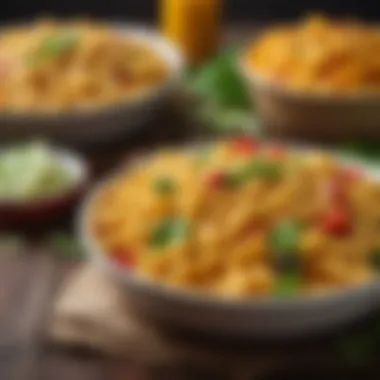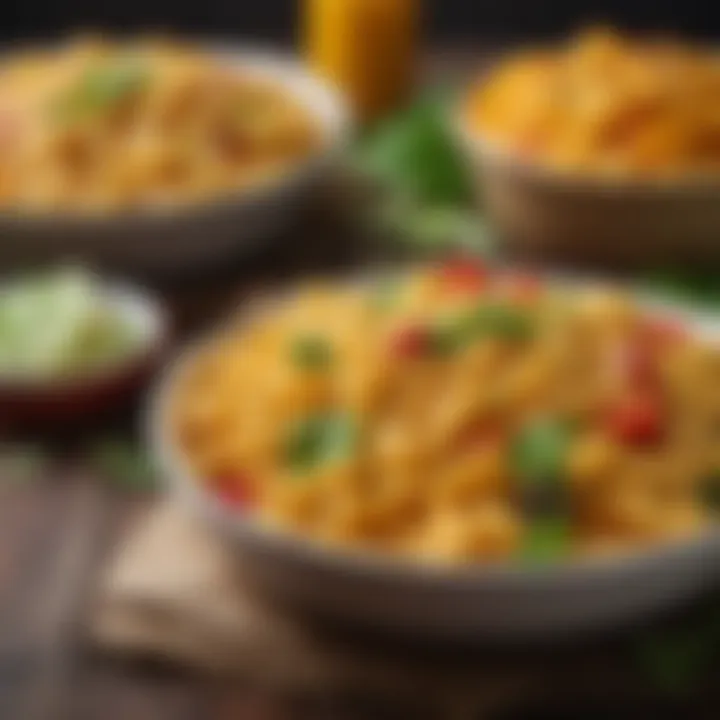Ultimate Vegan Mac and Cheese Recipes for Every Palate


Recipe Overview
Despite its reputation as a comfort food staple, Vegan Mac and Cheese can be a masterpiece that respects both your palate and dietary choices. This dish draws from a wide range of plant-based ingredients, making it both rich in flavor and macros.
Key Details
- Dish Name: Creamy Cashew Vegan Mac and Cheese
- Servings: 4 portions
- Preparation Time: 10 minutes
- Cooking Time: 20 minutes
- Difficulty Level: Easy
- Main Ingredients: Cashews, nutritional yeast, macaroni, plant milk, garlic powder, turmeric, salt.
Each component of this recipe serves a purpose. Cashews provide the creamy base, while nutritional yeast contributes a cheese-like richness. The method is straightforward, involving most steps that can be done in a single pot, making it ideal for quick preparations.
Step-by-Step Instructions
Making vegan mac and cheese requires some planning.
- Prep the Ingredients:
- Cooking the Macaroni:
- Make the Cheese Sauce:
- Combine and Serve:
- Soak 1 cup of raw cashews in warm water for about 20 minutes. This step softens the nuts for easier blending.
- Measure out 2 cups of macaroni. Use gluten-free or whole grain as preferred.
- In a large pot, bring water to a boil. Add a pinch of salt, then toss in the macaroni. Cook according to package instructions until al dente, about 8-10 minutes.
- Drain the macaroni and set aside.
- In a blender, combine the soaked cashews, 1 cup of plant milk, 1/4 cup of nutritional yeast, 1 teaspoon of garlic powder, 1/2 teaspoon of turmeric, and salt to taste. Blend until smooth.
- Heat the sauce in a pan over medium heat. Stir occasionally until warmed through.
- Add the macaroni to the sauce. Mix well. Adjust seasoning if necessary.
- Serve immediately, adding toppings like fresh herbs or cooked vegetables if desired.
Time-Saving Strategies and Substitutes
- Preparing the cashew soak in advance can cut down recipe time.
- You can substitute cashews with silken tofu for a different texture.
Nutritional Information
A serving of Creamy Cashew Vegan Mac and Cheese contains:
- Total Calories: Approximately 450 kcal
- Protein: 15 grams
- Total Fats: 22 grams
- Carbohydrates: 50 grams
Plant-based ingredients in this recipe are not just filling. They provide healthy fats from cashews, enzymes from turmeric, and vitamins from nutritional yeast, enhancing overall nutrition.
Quick Cooking Tips
To elevate your cooking experience, consider these efficient practices:
- Utilize a high-speed blender for a smoother sauce texture.
- Try using an Instant pot to reduce the cooking time.
Additionally, try to multitask by preparing your sauce while the macaroni cooks.
Related Recipes & Variations
Explore variations to keep your vegan mac and cheese experience diverse:
- Swap cashews for a sun-dried tomato base for a twist.
- For gluten-free options, use lentil pasta instead of traditional macaroni.
Gather friends or family to add personal twists to this recipe. Your enjoyment extends beyond preparation—it is a chance to connect over plant-based agréable meals.
Intro to Vegan Mac and Cheese
Vegan mac and cheese has emerged as a widely appreciated alternative to the traditional version, offering a blend of comfort and ethical eating. This unique culinary expression bridges dietary preferences and inclusivity without compromising flavors. As more individuals transition towards plant-based diets, understanding how to prepare vegan mac and cheese becomes essential for both novice cooks and experienced culinary enthusiasts.
This section not only provides toggle language between nutrition, personal choice, and culinary innovation but also highlights the relevance of vegan cuisine today. In a world increasingly focused on sustainable living, vegan mac and cheese embodies the wisdom of flavors derived from plants.
The Evolution of Mac and Cheese
Macaroni and cheese has a rich history that dates back to the 18th century and its early recipes can be traced to Italy. The idea was to combine pasta with cheese in a bake or casserole covering. Americans soon adopted the concept, creating their unique version much loved at gatherings and family meals. Over the decades, this dish has morphed, incorporating various cheeses and pasta shapes, eventually leading to its current customizable forms, including the exquisite vegan variant.
As dietary preferences have shifted, chefs and home cooks alike have started to innovate, seeking alternatives that accommodate those avoiding dairy. With the rise of health-conscious choices and nutrition awareness, the evolution of vegan mac and cheese signifies its growing acceptance in mainstream culinary spaces. Incremental changes in techniques and ingredients have resulted not just in preserving flavor but also enhancing nutritional value without the dietary compromises traditionally associated with mac and cheese.
Why Choose Vegan?
Choosing vegan mac and cheese offers several benefits beyond simply endurance of flavors around cheesiness. Firstly, a plant-based diet fosters better health outcomes long term. Typically, a recipe using vegetables, whole grains, and legumes provides valuable nutrients. Notably, this pasta dish can be rich in fiber, protein, vitamins, and minerals, depending on the chosen ingredients.
Additionally, avoiding animal products speaks to ethical choices—endorsing animal welfare and sustainability. This perspective taps into a poignant truth impacting today's society. With dairy agriculture coming under scrutiny for its environmental impact, vegan alternatives offer a bridge to mitigate that burden. Furthermore, adapting to embody your ethical values enables a richer, more satisfactory dining experience. Specifically, those desiring to create enjoyable meals without guilt will find options are flourishing. Julian Foragh's article in Britannica emphasizes both taste and mindfulness amidst culinary adventures.
In summary, embracing vegan mac and cheese aligns health considerations with ethical principles while also encouraging culinary exploration and experimentation.
Key Ingredients for Vegan Mac and Cheese
Key ingredients are the backbone of any dish. In vegan mac and cheese, they influence not just the flavor but also the texture and nutritional value. Identifying the right elements becomes essential for creating a satisfying and enjoyable experience that rivals traditional cheese macaroni. Incorporating the proper ingredients can elevate a simple recipe to a remarkable dish.
Nutritional Yeast: The Flavor Booster
Nutritional yeast is often regarded as a secret weapon in vegan cooking. It is rich in B vitamins and often fortified with vitamin B12, making it an excellent supplement in a plant-based diet. Its flavor is often described as cheesy, adding depth and umami character to vegan mac and cheese.


Adding nutritional yeast can enhance the overall taste without the calories of traditional cheese. The process in which yeasts are cultivated provides this nuanced flavor, offering a unique profile that complements pasta excellently. Just a few tablespoons can substantially alter the dish's flavor dynamic.
Plant-Based Cheese Alternatives
A wide variety of plant-based cheese alternatives exist, catering to those avoiding dairy. Common choices include almond cheese, cashew cheese, and soy-based options. Each type tends to vary in texture and flavor, presenting diverse possibilities for nailing that creamy consistency in mac and cheese.
Brands like Daiya and Violife have popularized such products, giving a substantial option for vegans. These alternatives can help one replicate the mouthfeel of traditional cheese while fulfilling dietary preferences. However, attention should be given to the ingredients, as not all products maintain wholesome profiles.
Pasta Variations: Choosing the Right Type
The choice of pasta can greatly influence the sorf texture and overall enjoyment of vegan mac and cheese. Most commonly, elbow macaroni is used, but alternatives like penne, fusilli, or even gluten-free options open new experiences. Each pasta shape interacts differently with the sauce, with texture varying as well, impacting the final presentation and mouthfeel.
Consider the cooking time and requirements. A sturdier pasta might soak up more sauce, creating a denser final dish. Enthusiasts often experiment with whole grain or high-protein pasta for added nutritional benefits. The right type should fit personal taste velvet.
Creamy Additions: Cashews or Tofu?
Adding creaminess is necessary for vegan mac and cheese, achieving that satisfying mouthfeel. Cashews, when blended, create a smooth and rich base that replicates traditional cheese sauces. Soaking cashews in water effectively softens them, producing a silky texture. Blend them until smooth to create the ultimate creamy base for your dish.
Alternatively, silken tofu can also provide a creamy aspect while being lower in fat and calories. It brings a lighter alternative without compromising richness. The decision between these two methods can depend on personal preferences regarding taste and texture.
Choosing key ingredients mindfully ensures a successful result that does not compromise flavor or texture is essential for building an enjoyable vegan mac and cheese experience. Integrating these components into your recipes provides the necessary foundation for satisfying dishes.
Basic Recipe for Vegan Mac and Cheese
The significance of mastering a basic recipe for vegan mac and cheese cannot be overstated. This dish serves as a foundation for innumerable culinary experiments and variations. It offers vegans and non-vegans alike an opportunity to indulge in the comfort of mac and cheese, commonly associated with creamy and satisfying flavors. Understanding the fundamental techniques also equips cooks to explore and integrate seasonal or available ingredients into their meals. A simple yet effective approach leads directly to unparalleled satisfaction without compromising dietary goals or health.
With the right balance of flavors and textures, a basic vegan mac and cheese ensures quick preparation suited for busy lifestyles while exercising inclusivity for health-conscious dietary choices. By grasping the ease of this recipe, people can appreciate its versatility. Dive deeper into various styles and methods while crafting a delicious meal that emphasizes wellbeing.
Ingredients List
Here, we consider several essential ingredients when preparing your vegan mac and cheese. Choosing the right items guarantees the perfect output.
- Pasta: Any shape of pasta works well. Look for whole grain or gluten-free options as needed. Conducted choices are elbow macaroni and shell pasta, which retain flavors effectively.
- Nutritional Yeast: This takes center stage by providing a cheesy flavor without dairy. About ½ cup suffices for the perfect savours.
- Non-Dairy Milk: Options such as almond milk, soy milk, or oat milk work best. Approximately 1 cup should be suitable to blend the texture rightly.
- Cashews or Tofu: Choose cashews for a nutty creaminess or silken tofu for a lighter base. Use around ¾ cup of either, depending upon preference.
- Spices: Important spices include garlic powder, onion powder, and turmeric. Each of them elegantly enhances the overall taste, approximately ½ teaspoon each is ideal.
- Salt and Pepper: Basic yet essential for bringing out the flavors of other ingredients. Adjust according to taste.
Step-by-Step Instructions
Going through the process methodically raises the chance of success. Follow below carefully laid out instructions:
- Cook the Pasta: In a large pot, boil water, and add a generous pinch of salt. Once boiling, add your chosen pasta. Cook according to the package instructions until it is al dente. Drain and set aside.
- Prepare the Cheese Sauce: In a blender, add cashews or tofu along with nutritional yeast, non-dairy milk, and all spices. Blend on high until the mixture achieves a smooth and creamy texture. If using cashews, soaking them for at least four hours makes for easier blending.
- Combine Ingredients: Pour the blended cheese sauce into the same pot where the pasta was cooked. Place it over low to medium heat. Fold in the pasta gently and heat until the sauce warms through completely. Be mindful to avoid overcooking at this stage to maintain a creamy texture.
- Taste and Adjust: At this step, sample your mix and adjust seasoning as necessary. This period encourages customization, drop in more spices as one likes.
- Serve: Once happy with the taste and consistency, plate up your vegan mac and cheese to enjoy it warm. Top inclusion options might incorporate some additional nutritional yeast or crushed red pepper flakes for an extra kick.
Success with this fundamental recipe opens doors for more complex and exciting variations. Thus, adept knowledge underlines every aspiring chef's journey toward exquisite vegan dining.
Variations of Vegan Mac and Cheese
Exploring variations of vegan mac and cheese offers a deeper appreciation for the flexible nature of this comfort food. By venturing beyond the basic recipe, one can discover a richer palette of flavors and ingredients. Each variation can highlights regions or personal preferences, making the dish not just a meal but a canvas for culinary creativity. Furthermore, variations ensure that every dietary taste and preference is catered to, providing limitless options for home cooks and food enthusiasts alike. The following sections will examine three popular variations, each with unique characteristics and appealing attributes.
Buffalo Vegan Mac and Cheese
Buffalo vegan mac and cheese infuses bold flavors into the traditional recipe. To achieve the Buffalo effect, Buffalo sauce is incorporated into the cheese sauce. This mix adds both heat and the unmistakable tang usually associated with Buffalo wings.
Ingredients:
- Main ingredients, including pasta, cashews, nutritional yeast and plant-based cheese
- Fresh activated spices: garlic powder, onion powder, and extra hot sauce
- Vegan butter or oil for texture
- Optional toppings, such as celery leaves or vegan ranch dressing
Preparation:
- Cook the pasta of your choice, choose elastic types like elbow or cavatappi. Avoid overcooking, as texture is crucial.
- Blend soaked cashews with water, nutritional yeast, infused spices, and Buffalo sauce until smooth.
- In a saucepan, add vegan butter on low heat; stir in the sauce gently as it starts to combine.
- Combine with the pasta, ensuring sauce evenly covers the macaroni.
- Serve immediately topped with extra Buffalo sauce and crumble of celery.
Buffalo vegan mac and cheese acts as a crowd-pleaser at gatherings. The spicy kick makes this variation a quick way to elevate a comforting dish into an exciting entree.
Veggie-Packed Mac and Cheese
Veggie-packed mac and cheese is a strategic approach to incorporating essential nutrients into a beloved meal. This variation replaces some sauce components with mixed colorful vegetables, enhancing both texture and taste. Additionally, it adds vibrant color to the dish, appealing visually.
Ingredients:
- Make use of seasonal vegetables such as spinach, bell peppers, or broccoli
- Nutritional yeast and cashews still serve as the base for the cheese sauce
- Use heaps of fresh herbs like dill or basil
Preparation:
- Steam or roast vegetables accordingly until slightly tender, yet retaining their crunch. Prevent overcooking this step for better retention of color and nutrients.
- Proceed making the cashew cheese sauce as delineated in the basic recipe.
- Combine pasta with cheese sauce and mix in seasoned vegetables evenly.
- A sprinkle of vegan parmesan on top adds an attractive finish.
Emphasizing veggies in this mac and cheese version not only results in a healthier meal but contributed fiber and essential vitamins without sacrificing taste.
Smoky Vegan Mac and Cheese
Smoky vegan mac and cheese taps into growing popularity for smoky flavors, reminiscent of barbeque meals. Smoky liquid criminally adds depth to the cheesy combination and provides unforgettably multilayered experiences for the palate.
Ingredients:


- Liquid smoke (used in moderation)
- Use smoked paprika as well for added impact
- Common ingredients: pasta, cashews, and nutritional yeast being prominent choices
Preparation:
- Boil and drain pasta of choice as per basic directions.
- Soak cashews, then blend to make the creamy base.
- Spice the sauce with smoked steaks – plain nutritional yeast won't not suffice.
- Combine add pasta and serve immediately while the sauce integrates flavors toward(udding its dimensions).
Making such an effort prepares dishes for an audience longing for smokier notes, delighting those ready to indulge in vegan gastronomy.
The exploration of variants not only enhances flavor but widens approachability to various consumers and dining settings, keeping vegan mac and cheese far from monotony.
By adding variety to vegan mac and cheese, one embraces not only personal preferences but ensures these variations maintain energy and excitement around this classic dish.
Techniques for Achieving Optimal Texture
The texture of vegan mac and cheese plays a pivotal role in replicating the classic comfort food experience. It is essential to create a dish that is not only pleasing to the eye but also satisfying to bite into. The methods employed to achieve the ideal texture are crucial for the overall success of the recipe. Two primary techniques stand out: blending ingredients to create creaminess and determining the cooking method—be it baking or stovetop. Both aspects deserve careful consideration for the best outcome.
Creating Creaminess with Blends
To mimic the richness found in traditional mac and cheese, blending is fundamental. When it comes to vegan versions, using blends of certain ingredients can provide that creamy and smooth consistency people desire.
Cashews are a prime candidate for creating vegan cream. By soaking them and then blending them into a smooth paste, cashews impart a natural creaminess that satisfies the palate.
Additional ingredients to consider in your blend include:
- Tofu: Silken tofu can work well, contributing a velvety texture.
- Nutritional Yeast: It generates a cheesy flavor while also enhancing the creaminess.
- Plant-Based Milk: Almond, soy, or coconut milk can contribute to the desired texture while keeping the mix lighter.
A good ratio is crucial. Using too much liquid can result in a runny sauce. Therefore, blending these elements effectively will help achieve that coveted creamy sauce, crucial over a delightful bed of pasta.
A successful vegan mac and cheese serves not just a healthy meal, but also an elevated taste and experience.
Baking vs.
Stovetop Methods
Deciding between baking and stovetop methods has significant implications on the final texture of vegan mac and cheese. Each technique offers different benefits and caters to varied preferences.
Stovetop Method
The stovetop approach is quicker. You cook your pasta and mix it right in the pot with the prepared sauce. This method tends to produce a creamier finish since the heat helps emulsion and additional blending occurs as you combine ingredients.
Advantages:
- Faster preparation time, usually under 30 minutes.
- Immediate tasting adjustments can enhance flavors swiftly.
Disadvantages:
- Lack of a gooey crust that some may crave as part of the traditional experience.
Baking Method
The baking method introduces a different texture altogether. Here, a baked crust adds more depth and a toasty flavor. Baking takes longer but also allows the flavors to meld beautifully. It provides a delightful contrast between the soft noodles underneath and a slightly crispy topping on top. This method often includes breadcrumbs mixed with seasoning, which offer an added crunch.
Advantages:
- Adds unique flavor complexity with a crunchy top.
- Longer bake brings out ingredients' flavors that might otherwise remain muted.
Disadvantages:
- Takes more time; typically at least 45 minutes.
Complementary Side Dishes
When enjoying vegan mac and cheese, complementary side dishes play a significant role in rounding out the meal. They can enhance the overall dining experience, providing texture, more flavors, and even nutritional balance. They help to bring variety, making a rather simple dish into a complete culinary experience. A well-rounded meal involves not only what is on the plate but how those flavors and textures play together.
Side dishes can either contrast with or complement the rich, creamy profile of mac and cheese. For instance, crisp salads can introduce freshness and acidity, whilst warm breads may provide comfort and heartiness. In addition, the right beverages can heighten the flavors present in the dish.
In this section, we will explore two main types of side dishes: salads and breads. These areas contribute distinctly to a satisfactory and enjoyable meal. With thoughtful pairing, the table can transform from ordinary to tempting and delicious. As a result, your vegan mac and cheese will resonate on multiple tasting fronts and provide an excellent plant-based dining experience.
Salads to Pair with Vegan Mac and Cheese
Salads serve as a refreshing contrast to the richness of vegan mac and cheese. Their bright, crisp textures and flavors can enhance and even elevate the entire meal. Salads add both nutritional benefit and visual appeal to the plate. Here are some ideas:
- Arugula Salad with Lemon Dressing: The peppery notes of arugula cut through the creamy cheese sauce and the zesty dressing brightens the overall flavor.
- Mediterranean Chickpea Salad: Combining chickpeas, cucumbers, tomatoes, and olives offers protein and different textures that add variety to the meal. The salty olives can enhance the mac and cheese's savory bite.
- Cabbage Slaw with Apples and Carrots: The crunch of cabbage combined with sweet apples creates an interesting combination alongside the mac and cheese, adding depth to the meal's flavor.
When selecting salad ingredients, consider ingredients that provide acidity and crunch as they help to mask heaviness from the mac and cheese. Flavorful oils or tangy vinaigrettes can be a great addition, too.
Breads That Enhance the Meal
Bread can create a comforting contrast to the cheesy richness of vegan mac and cheese. The complexity gained from a delicious bread component can modify the dining scene. Here are a few bread options to consider integrating into your meal:


- Garlic Bread: This classic option, with its buttery garlic finish, pairs beautifully with vegan mac and cheese.
- Herb Focaccia: The subtle herb flavors shared within focaccia enhance both freshness and enjoyment, making it a delightful companion.
- Whole Wheat Baguette: Offering your mac and cheese alongside slices of baguette gives diners the ability to scoop up any extra cheese on their plate, enriching the experience on every level.
Bread can also provide a base for topping with herbs or nutritional yeast, increasing complex flavors further.
Combining these sides can construct an enjoyable and pleasing meal around vegan mac and cheese. By being intentional with flavor notes and textures, the overall culinary result improves significantly.
Common Mistakes to Avoid
When preparing vegan mac and cheese, observing best practices can greatly impact the final dish. Avoiding common mistakes ensures optimal flavors and textures without considerable effort. Understanding what can go wrong is important for achieving a satisfying meal that meets dietary preferences.
Overcooking the Pasta
Overcooking pasta is probably one of the most frequent errors, and it perhaps seems unimportant; however, it compromises the entire dish. When pasta is overcooked, it becomes mushy and does not hold its shape. The texture is vital for the overall experience of mac and cheese in any form. To avoid this issue, it is crucial to pay attention to cooking times based on the type of pasta used.
A general guideline is to experiment with the timing; usually, reducing the suggested time on the packaging by one to two minutes achieves the desired aldente texture. Additionally, rinsing the pasta with cold water after cooking can strengthen its structure and halt the cooking process.
Underseasoning the Sauce
Underseasoning, while often overlooked, dulls flavor profiles and results in a bland dish. Vegan cheeses and plant-based sauces require an appropriate amount of seasoning to enrich the taste. Neglecting to season properly can create a dish that feels listless and unenjoyable.
To enhance flavor, consider using a mix of salt, pepper, garlic powder, onion powder, and nutritional yeast. Incorporating these spices not only supports the taste but adds depth. Sampling the sauce during cooking can help identify if it needs more seasoning. Adding salt incrementally can often lead to the perfect balance without overpowering the dish.
"Understanding the basics can eliminate the common pitfalls that lead to disappointing results in vegan mac and cheese preparation."
Storage and Reheating Tips
When it comes to enjoying vegan mac and cheese beyond its initial preparation, understanding storage and reheating tips becomes essential. Proper storage ensures that the food retains its flavor and texture, while effective reheating contributes to a delightful dining experience. Ignoring these aspects can lead to a less appetizing meal, detracting from the interesting culinary journey that vegan mac and cheese can provide.
How to Store Leftovers Effectively
Storing leftovers of vegan mac and cheese demands a few straightforward yet critical steps to maintain the integrity of the dish.
- Cool Before Storing: Allow the mac and cheese to cool down to room temperature. Storing hot food causes condensation, leading to sogginess.
- Choose the Right Container: Opt for airtight containers. Glass containers or high-quality plastic can keep the flavors intact and prevent moisture loss.
- Portion Wisely: Consider dividing the mac and cheese into smaller portions. This allows for quick access and minimizes reheating time, ensuring each serving is enjoyed fresh.
Ensure to label the container with date to track freshness. Most properly stored leftovers can last for about three to five days in the refrigerator.
Best Methods for Reheating
Reheating vegan mac and cheese might seem simple, but the method used can significantly impact taste and texture. Here are some best practice methods:
Stovetop Method
- Pour the desired amount into a small pot.
- For added creaminess, mix in a splash of plant-based milk or a small amount of vegan butter.
- Heat over medium-low while stirring occasionally to prevent sticking. This method helps maintain moistness and avoids a dry outcome.
Microwave Method
- Place the portion in a microwave-safe bowl.
- Cover with a lid or damp paper towel.
- Reheat in intervals of 30 seconds, stirring in between until thoroughly heated. Make sure not to overheat, as this can toughen the dish.
“Reheating vegan mac and cheese with some liquid can recreate the creaminess found in fresh preparation.”
By applying these storage and reheating techniques, you can ensure that every mouthful remains as appetizing as the first. Enjoying leftovers shouldn't be a compromise; by following these steps, you can savor vegan mac and cheese several days after its initial preparation.
Exploring Nutritional Benefits
The exploration of nutritional benefits in vegan mac and cheese is crucial, especially as more people seek healthier eating options without compromising on flavor. This aspect underscores the capacity of plant-based cooking to meld health and satisfaction effectively. By highlighting the vital elements within this dish, this section demystifies misconceptions regarding nutrition in vegan meals while demonstrating how these choices can sooth both the palate and one's wellbeing.
Protein Sources in Vegan Mac and Cheese
Protein is a major concern when transitioning to a vegan diet. Contrary to popular belief, vegan mac and cheese can provide a sstrong supply of this macronutrient. To enhance the protein content, individuals often turn to ingredients such as:
- Nutritional yeast – This ingredient not only fortifies dishes with a cheesy flavor but also offers around 8 grams of protein per two tablespoons. It is also rich in B-vitamins.
- Legumes such as chickpeas or kidney beans. These beans can be blended into sauces or included in the dish itself, significantly increasing protein while adding heartiness.
- Lentils are another fantastic source of plant-based protein, attributed particularly to their versatility. They can be easily integrated into recipes, enhancing both taste and nutrition.
Overall, incorporating these sources ensures that the dish serves as a sound nutritional choice rather than merely a comfort food.
Vitamins and Minerals from Plant-Based Ingredients
Utilizing diverse plant-based ingredients unlocks a wellspring of vitamins and minerals essential for overall health. Embracing vegetables, legumes, nuts, and seeds opens pathways for nutrition that may not be as readily available in animal products.
Key vitamins and minerals to consider in vegan mac and cheese include:
- Vitamin A: Derived from carrots or nutrient-rich squash, it contributes significantly to eye health and immune function.
- Vitamin C: By adding spinach or peas, the dish garners a boost in this vitamin, critical for skin health and iron absorption.
- Magnesium: Present in cashews and almond milk, carbohydrates, magnesium is vital for energy production and muscle function.
- Iron: Ingredients like nutritional yeast and lentils also offer iron, which can help combat fatigue and maintain optimal energy levels.
By thoughtfully choosing components, one not only creates a palatable dish but builds a solid nutritional foundation that supports a healthy lifestyle. Overall, the exploration of these nutritional facets enhances awareness of the potential vegan mac and cheese has, shifting it into a realm of culinary and nutritional merit.
End: Mastering Vegan Mac and Cheese
In this article, we explored the myriad dimensions of vegan mac and cheese. Embracing this plant-based dish is more than a culinary trend; it serves as a bridge to diverse diets and culinary creativity. Mastery of vegan mac and cheese lies not just in knowing the recipes but in understanding its fundamental components and how to manipulate them to suit personal preferences.
The ingredients discussed represent foundational pillars. Nutritional yeast enhances flavor, while plant-based cheese alternatives offer varying taste profiles. Pasta selection affects texture, and the choice between cashews or tofu can provide rich creaminess. Each ingredient plays a critical role in crafting the ideal dish—one that can satisfy palate and conscience simultaneously.
Encouraging Experimentation with Ingredients
Cooking, especially a comfort-food classic such as mac and cheese, should invite adventure. Substitutions for traditional ingredients lead to varying profiles. For example, for a spicy kick, consider incorporating jalapeños or sriracha. You may prefer using a coconut-based cheese for sweetness, or even a mix of lentils to amp up protein content. Don't shy away from adding a medley of vegetables for enhanced nutrition.
Creating your vegan mac and cheese shouldn't feel restrictive; allow for trial and error. Collaborating with different textures and flavors may illuminate unexpected delights that can become personal favorites. Experimentation opens the door to unique interpretations, fostering enjoyment in your cooking journey.
Here’s a prime example: if adding pumpkin puree to your creamy sauce strikes your fancy, give it a try. Enjoyment in cooking is a path to culinary development. Remember, vegan mac and cheese is about expressing your individual taste while offering a sensation that resonates with broader trends of sustainability and health consciousness. Let each bite reflect your creativity and foresight.







